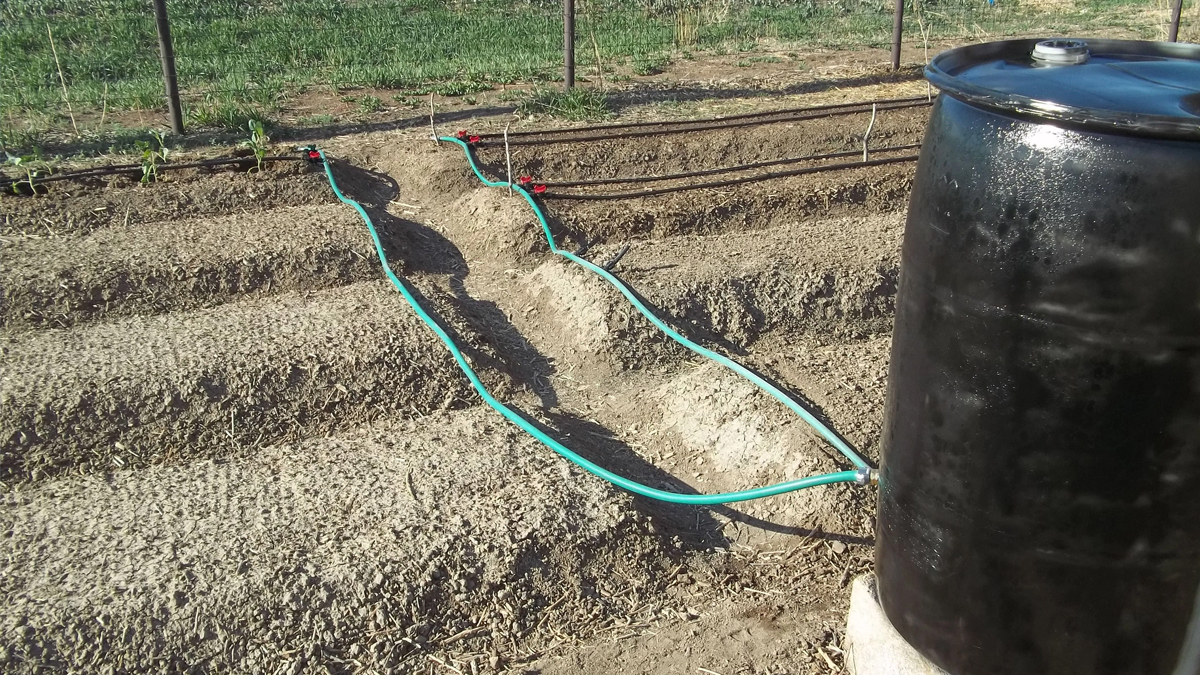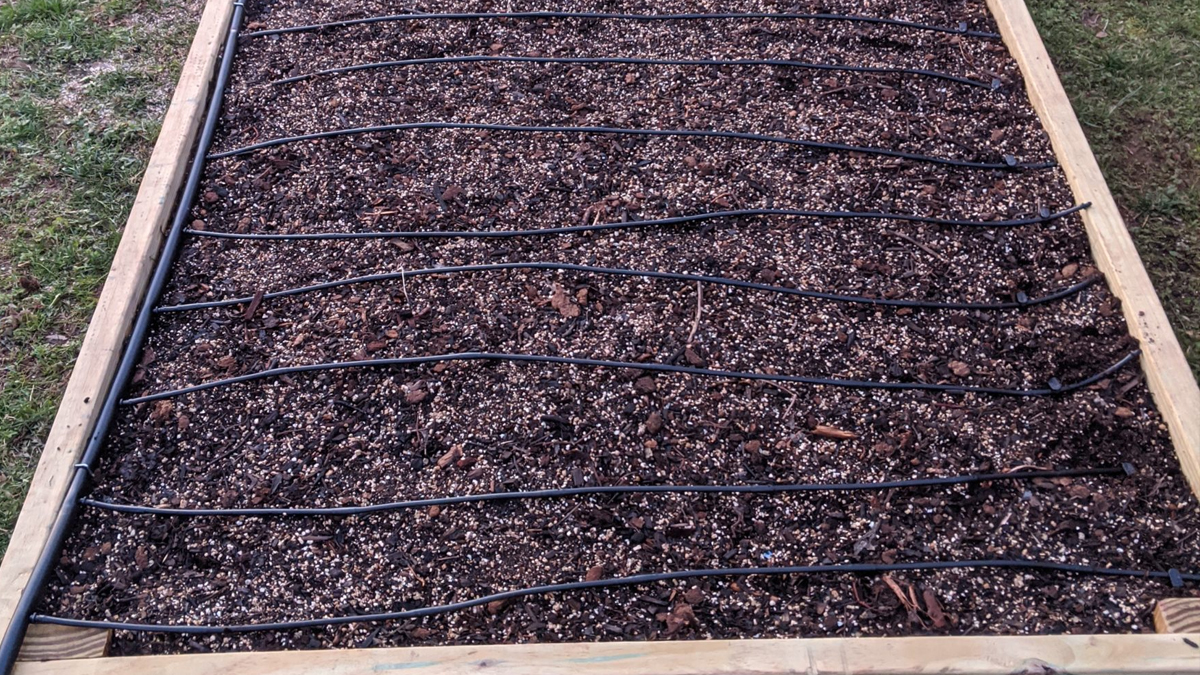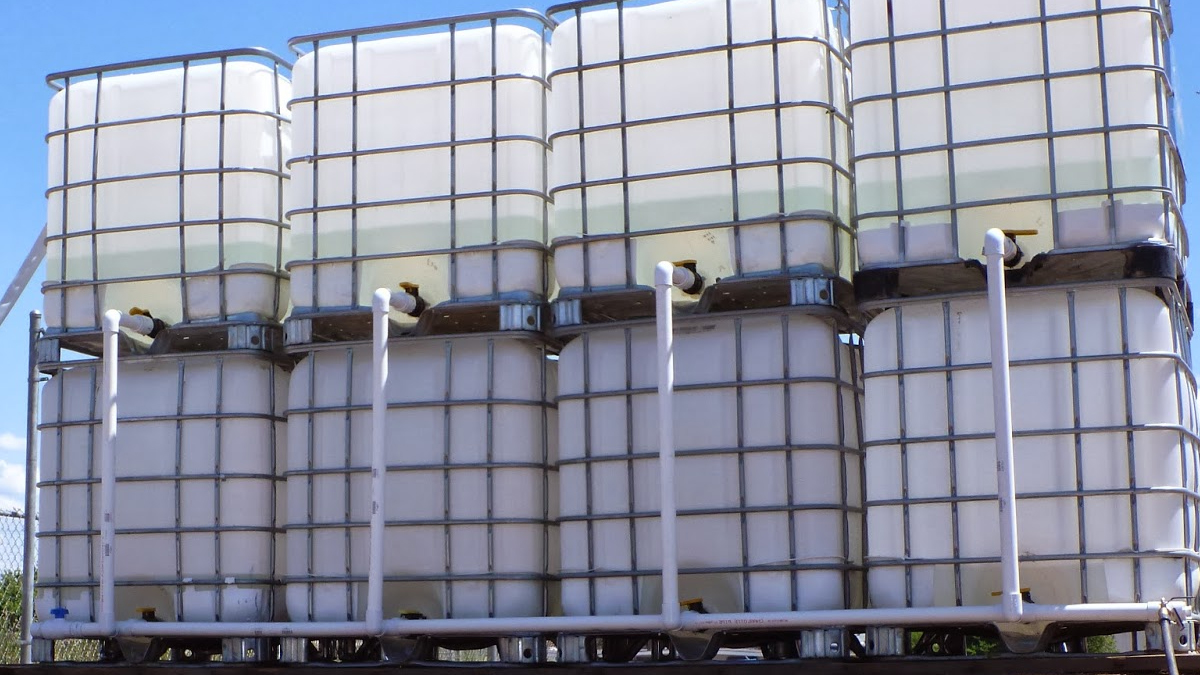on
With gravity irrigation, you can water plants anywhere, in the ground or in containers, even if there’s no electricity available. These systems work by taking advantage of water’s ability to travel the path of least resistance all on its own. You don’t need any pumps and can use this for watering your garden temporarily or all season long. It is best used on individual plants, small clusters, or row crops.
Without a pump, you need a reservoir. You can fill it with collected rainwater, from the hose, or transported from nearby a pond or stream. The water moves to your plants’ roots through drip irrigation. Just don’t forget to check your water level. It will run out faster than you expect during a drought or a dry climate, especially as your plants grow larger. You can also add fertilizer or nutrient supplements to your irrigation reservoir.
No Pressure Drip Irrigation
The great thing about drip irrigation is that it doesn’t actually require any pressure, just water in the line. Water will keep flowing downward until it has nowhere else to go. That means as long as your drip line stays below the water level in your tanks, you can irrigate with gravity.
There are a couple of important considerations, though:
1. Slope and Distance
Friction loss occurs when water moves along the inside of a pipe. This limits the distance water will travel on a flat site. If your site is completely flat, you can expect about 20 – 25 feet of distribution through your drip lines.
The best way to think about this is to measure a 25-foot radius around your rainwater tank. For example, if you have a drip irrigation connection on multiple links rain barrels, you can extend each line 25′ in opposite directions. And you can tee off your mainline to service the entire area within that 25′ proximity of your stored water.

Raising your water reservoir or rain barrel will extend the distance you can expect distribution. Most experts suggest an elevation of 4ft. Any higher and it becomes harder for you to access the container to add fertilizer or water if you are toting it in. It works on the same principle as the water towers that are such a common sight in small towns.
Growing Tip: If you’re working with a flat site and using pre-drilled inline dripline (recommended for veggie rows), plant the most water-loving plants closest to the water source, with more drought-tolerant plants farther away. Friction loss will cause output to decrease farther down the line, so account for this in your planting.
2. Watering Time
Keep in mind that while all drip irrigation systems are designed for low pressure, most operate on 12 – 20 PSI (pounds per square inch). A gravity fed system will only offer between 0 and 2 PSI if you are on a flat site, depending on how full your barrels are.
This doesn’t mean the system won’t work. You will just need to leave the water on for longer to get the desired output. For example, your drip line may have a 1 GPM (gallon per minute) rating, but a gravity-fed line will take longer than a minute to emit one gallon. So experiment and observe to see how much water your plants really need.
If your barrels are elevated, your pressure may be higher (each linear foot of elevation in the water column creates 0.43 PSI). Keep in mind that gravity-fed systems work most efficiently with pressure below 6 PSI (the amount of pressure created by 14′ of elevation).
One benefit to slower water delivery is increased saturation efficiency. So while you may expect to double your irrigation time, don’t be surprised if you find an extra 5 – 10 minutes does the trick.
Drip irrigation vs. soaker hose
A soaker hose is a porous garden hose. Water flows through the hose and seeps slowly out through the walls. When you run a soaker hose between plants, you can water an entire row simultaneously. Drip irrigation is a long tube to which are attached smaller emitter tubes. The tubes drip water at the base of plants. Though similar, when considering whether to install a soaker hose or drip irrigation, consider the different uses and advantages of each system.
Both types of irrigation allow you to put water at the base of plants. Watering near the ground rather than sprinkling from above has several advantages. First, when you water at ground level you are targeting the plants more accurately. You are watering just the plants, not the weeds around the plants.

You are also able to keep the leaves of the plants dry. Doing so minimizes the chance of mildew and other diseases that need a damp environment to grow. It also prevents any treatments, such as fungicides or insecticides, from being washed off of the plants during watering. Finally, ground-level irrigation minimizes the evaporation that is inevitable when you spray small droplets of water through the air.
Soaker hoses are cheaper to set up than drip lines, however the watering is less precise which could result in watering weeds between your plants. When it comes to durability, if both lines are covered by mulch and kept away from the sun they will last for several seasons. But should they be damaged and in need of repair, the drip-line is easier as you can just pop in a new emitter, while the soaker hose will need to be repaired by cutting out the damaged section, thereby shortening the hoses length and the spot where the hose is repaired will no longer soak.
Either system will work with low flow gravity systems, although drip irrigation works a little better. Timers help can help you make the most of your water supply by turning off and on as programed. This means you could be watering at the same time as the morning dew, which is the most efficient time. In fact your watering could be done for the day before you even finish your first cup of coffee if you aren’t a super early riser.
More information
For a demonstration of setting up a system using a water tank and gravity for irrigatiaon check out this video from John Kaisner from The Natural Farmer. He has a permaculture farm located in Scilly. And he uses some very unique emitters with his drip lines.
Get access to premium content and more!





